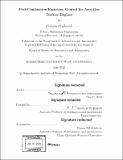Post-combustion emissions control for aero-gas turbine engines
Author(s)
Prashanth, Prakash.
Download1119722608-MIT.pdf (4.745Mb)
Other Contributors
Massachusetts Institute of Technology. Department of Aeronautics and Astronautics.
Advisor
Steven R. H. Barrett.
Terms of use
Metadata
Show full item recordAbstract
Aviation NO[subscript x] emissions have an impact on air quality and climate change, where the latter is magnified due to the higher sensitivity of the upper troposphere and lower stratosphere. In the aviation industry, efforts to increase the efficiency of propulsion systems are giving rise to higher overall pressure ratios which results in higher NO[subscript x] emissions due to increased combustion temperatures. This thesis identifies that the trend towards smaller engine cores (gas generators) that are power dense and contribute little to the thrust output presents new opportunities for emissions control that were previously unthinkable when the core exhaust stream contributed significant thrust. This thesis proposes and assesses selective catalytic reduction (SCR), which is a post-combustion emissions control method used in ground-based sources such as power generation and heavy-duty diesel engines, for use in aero-gas turbines. The SCR system increases aircraft weight and introduces a pressure drop in the core stream. The effects of these are evaluated using representative engine cycle models provided by a major aero-gas turbine manufacturer. This thesis finds that employing an ammonia-based SCR can achieve close to 95% reduction in NO[subscript x] emissions for ~0.4% increase in block fuel burn. The large size of the catalyst needs to be housed in the body of the aircraft and hence would be suitable for future designs where the engine core is also within the fuselage, such as would be possible with turbo-electric or hybrid-electric designs. The performance of the post-combustion emissions control is shown to improve for smaller core engines in new aircraft in the NASA N+3 time-line (2030-2035), suggesting the potential to further decrease the cost of the ~95% NO[subscript x] reduction to below ~0.4% fuel burn. Using a global chemistry and transport model (GEOS-Chem) this thesis estimates that using ultra-low sulfur (<15 ppm fuel sulfur content) in tandem with post-combustion emissions control results in a ~92% reduction in annual average population exposure to PM₂.₅ and a ~95% reduction in population exposure to ozone. This averts approximately 93% of the air pollution impact of aviation.
Description
Thesis: S.M., Massachusetts Institute of Technology, Department of Aeronautics and Astronautics, 2018 Cataloged from PDF version of thesis. Includes bibliographical references (pages 47-50).
Date issued
2018Department
Massachusetts Institute of Technology. Department of Aeronautics and AstronauticsPublisher
Massachusetts Institute of Technology
Keywords
Aeronautics and Astronautics.